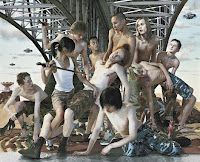 JTF (just the facts): A total of 7 large scale photographs, framed in white with no mat, and hung in the main gallery space. The archival pigment prints are sized 45x61 or reverse, and are available in editions of 6+2. All of the works were made in 2007. Signed monographs are available from the gallery for $75. (Installation shots at right.)
JTF (just the facts): A total of 7 large scale photographs, framed in white with no mat, and hung in the main gallery space. The archival pigment prints are sized 45x61 or reverse, and are available in editions of 6+2. All of the works were made in 2007. Signed monographs are available from the gallery for $75. (Installation shots at right.).
Comments/Context: Given the long history of iconic New York photographs, deciding to take on the challenge of seeing famous New York landmarks in an original way takes a certain kind of artistic confidence. What more can really be said about Times Square, the Flatiron Building, or Coney Island?
.
Italian photographer Olivo Barbieri has been making aerial photographs of famous world cities since 2004. Using a tilt-shift lens, his bird's eye images of recognizable architecture have been transformed into real-life architectural scale models, or tabletop toy set-ups with ant-sized people. The lens provides a shallow depth of field, so much of the image is semi-blurred, leaving only a small area of sharper focus where the detail is crisp ("selective focus"); the effect is to render reality with more impressionistic flair.
.
 Barbieri's images of New York city make many of our hackneyed subjects seem fresh once again. I particularly enjoyed the vibrant swath of green of Sheep's Meadow, where the crowd of sunbathers on towels has become a blur of blinding polka dots. The amusement park rides of Coney Island are another highlight, the playful colors and shapes restyled into a swirling mass of interconnected lines. The roof garden of the Met is likely the least known scene on display, with its pyramidal striped roof and irregular geometric hedge.
Barbieri's images of New York city make many of our hackneyed subjects seem fresh once again. I particularly enjoyed the vibrant swath of green of Sheep's Meadow, where the crowd of sunbathers on towels has become a blur of blinding polka dots. The amusement park rides of Coney Island are another highlight, the playful colors and shapes restyled into a swirling mass of interconnected lines. The roof garden of the Met is likely the least known scene on display, with its pyramidal striped roof and irregular geometric hedge..
While the novelty factor is always high for me with tilt shift photography, I wonder a bit about what lies beneath the decorative fun. Perhaps the answer is that these images so radically alter our common perception of a place that we are forced to see it with new eyes, in the process discovering details and nuances that we had wholly overlooked.
.
Collector's POV: The works in this show are priced at either $19700 or $23700. Barbieri's photographs have very little secondary market history, so gallery retail is likely the only option for interested collectors at this point. Another contemporary photographer who has embraced the use of a tilt-shift lens is Naoki Honjo (here).
.
Rating: * (one star) GOOD (rating system described here)
Transit Hub:
Olivo Barbieri, site specific_NEW YORK CITY 07
Through May 28th
Yancey Richardson Gallery
535 West 22nd Street
New York, NY 10011






















 The 2010 representatives of the documentary/straight approach to photography pack such an emotional wallop that they seem to be saying: make the content extreme or just go home. Stephanie Sinclair’s desperate images of Afghan women charred by self-inflicted burns are bloody and horrifying, so much so that the exhibition room was filled with gasps, “My God”s, and uncomfortable intakes of breath; the suffering and violence that is depicted is harsh and shocking, but entirely unforgettable. Nina
The 2010 representatives of the documentary/straight approach to photography pack such an emotional wallop that they seem to be saying: make the content extreme or just go home. Stephanie Sinclair’s desperate images of Afghan women charred by self-inflicted burns are bloody and horrifying, so much so that the exhibition room was filled with gasps, “My God”s, and uncomfortable intakes of breath; the suffering and violence that is depicted is harsh and shocking, but entirely unforgettable. Nina 





